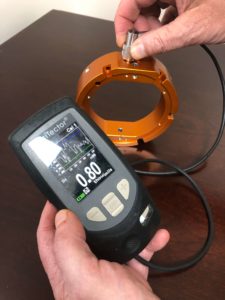An Easier Way to Determine Pre-Plating Dimensions for CNC Machining
“What coating thickness range can I expect from anodizing or hardcoat anodizing?”
When engineers and machine shops need anodizing services, this is one of the most common questions they ask their metal finishing partner.
Anodized coatings change the dimensions of a part, so customers understandably need to know how much growth to account for in their pre-plating dimensions. This information is especially important for parts that must maintain certain tolerance ranges or mate with other components during assembly.
Global Metal Finishing is intent on making the metal finishing process as easy and seamless as possible for our customers. To that end, we developed a coating thickness cheat sheet to help engineers and machinists understand how coating thicknesses can meet their final dimension requirements every time.
Today, we’ll dig deeper into this important topic, reviewing key considerations for pre-plating dimensions as well as offering advice to ensure that you and your metal finishing partner are speaking the same language.
Key Considerations for Pre-Plating Dimensions
Surface dimension.
For hardcoat anodizing in particular, it’s critical to make allowances for dimensional increase and to specify both a machining dimension and a coated dimension on the drawings provided to a metal finisher.
Expect an increase in dimension equal to one half the thickness of the applied coating for each surface coated. If, for example, a 0.004” coating will be applied on close tolerance parts, there should be a 0.002” pre-machining allowance per surface prior to hard coating.
Thread hole dimensions.

All types of anodized coatings will have an effect on the thread dimension of both external and internal threads:
- the major and minor diameter will increase 2x the amount of growth
- the pitch diameter for threads with an included angle of 60 degrees will increase 4x the amount of growth
- the pitch diameter for threads with an included angle other than 60 degrees will increase 2x the amount of growth divided by the sine of half the included angle
Sharp edges and corners.
Anodized coatings are prone to developing voids at sharp corners and edges, so it’s a best practice to avoid these features if possible—especially for hardcoat anodized coatings.
When edges and inside corners are present, they should be radiused prior to anodizing, and chamfering should be avoided unless the resulting sharp edges are radiused.
When In Doubt, Talk to Your Metal Finishing Partner
If you have specific requirements for your part, the best course of action is to get your metal finisher involved as early in the process as possible.
Together, we can discuss options like using regular anodize instead of hardcoat anodize for parts that may not require the latter. We may also have the opportunity to add more or less coating to get your final part into spec—provided we’re able to connect with you about it ahead of time. Consider engaging us as early as the design phase so we can provide expert advice and solutions before machining even begins.
It’s also important during these conversations to ensure that you’re speaking the same language as your metal finisher.
Unlike other plating processes, anodizing penetrates the aluminum’s substrate and then builds additional coating on top of it, resulting in roughly 50% penetration and 50% buildup. When discussing overall buildup, anodizers tend to speak in terms of the totality of the coating thickness (i.e. penetration and buildup), while machinists tend to speak in terms of the buildup only.
Discrepancies in this terminology can lead to miscommunications between machine shops and metal finishing shops—a problem that our coating cheat sheet aims to resolve.
Specifying coating thickness can be challenging. . . but it doesn’t have to be. Download our free coating thickness cheat sheet and meet final dimension requirements every time.
